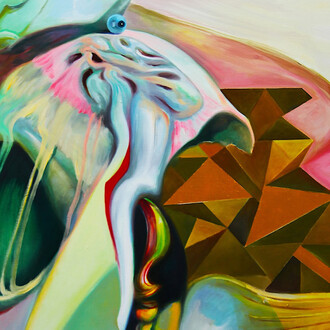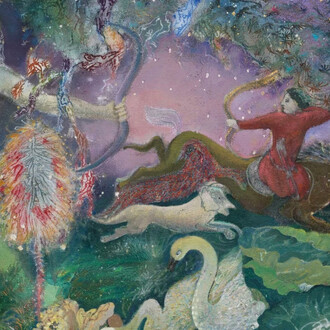Hannah Traore Gallery is pleased to present Rachel Martin’s first solo exhibition in New York, Bending the rules. Comprised of fifteen new works on paper that celebrate generational cultural and communal joy, the show honors summertime traditions of food-gathering practices, self-sustainability, and community through Martin’s storytelling. In centering food as a connection to home, the artist acknowledges the urban environment of New York in which she currently resides.
The exhibition takes its title from Martin’s eponymous work Bending the rules (2024). For the artist, working from a place of imperfection—or, bending the rules—is a vital way of keeping traditions alive and dynamic. Martin has described herself as making mischief through her art practice by existing and holding space in the places where she is not supposed to be—whether in relation to the ways she navigates the perceived rules of formline, or by bending western patriarchal rules by creating celebratory art as an Indigenous person. The show’s titular artwork, as well as Wolf brows 4 life (bender series) (2024) reference this rule-bending, with figures performing literal backbends, and represent bridges—to other worlds and to other ways of viewing this world.
Martin’s Tlingít identity, and her process of formally learning the language, inform and are embedded within her practice. In varying degrees, she combines iconography and aesthetics from the Northwest Coast with representations of popular culture, contemporary life, and colonial inheritances. Growing up in Southern California and the Fort Peck Indian Reservation in Montana, Martin learned about Tlingít culture later in life and has a unique relationship with tradition. Over time, her depictions of Alaska Native culture have developed from broader representations to more specific renderings of her family’s cultural history.
The works in Bending the rules include formline, a Northwest Coast form of design made with curvilinear shapes that is most traditionally used in carvings, totem poles, and masks, or on large canvases with paint. Martin’s use of formline is apparent in the bodies and masks of the figures in Love is a tide is a taste is a seed is a tree (2024); the traditional Chilkat woven robe of the figure in She’s a 10 but she boils herring eggs until they’re all white and rubbery (2024); and the hair, earrings, and facial features of the figure in Beach hairs (2024). The instantly recognizable design is imbued with humor and imperfection, adorning the paintings with Nike sneakers or styling the figure’s with hair pulled into a top knot demonstrating how her practice is an extension—and exploration—of a much larger story.
If Our table could talk (2024) further represents Martin’s distinct viewpoint in blending tradition and contemporary culture. Eight plates, all differently decorated and serving distinct meals, sit atop a rectangular table. Some of the meals are inspired by dishes Martin has been offered when visiting home, while others reference photos sourced from her Indigenous community. Here, the artist’s playful use of formline is paired with hyper-realistic, figurative representations of food, yet each plate and meal is humorous and celebrates the joy of sharing sustenance.
Martin’s use and expansion of tradition complicates and adds texture to that which is often flattened through colonization; the work challenges the singularity that coloniality has imposed on definitions of Indigeneity. Instead, Martin reinvests in tradition by bringing in her own perspectives, all in service of celebrating cultural legacies and communal joy.
(Written by Cicely Haggerty)
















